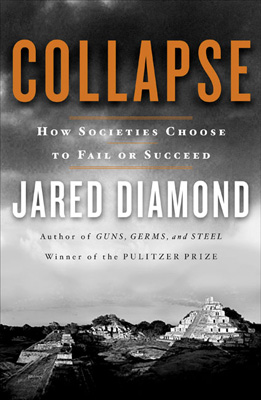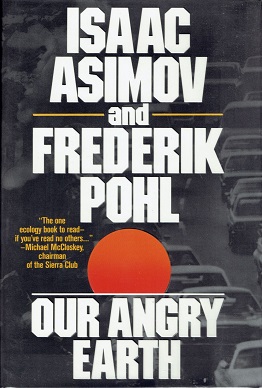
The Population Bomb is a 1968 book co-authored by former Stanford University professor Paul R. Ehrlich and former Stanford senior researcher in conservation biology Anne H. Ehrlich. From the opening page, it predicted worldwide famines due to overpopulation, as well as other major societal upheavals, and advocated immediate action to limit population growth. Fears of a "population explosion" existed in the mid-20th century baby boom years, but the book and its authors brought the idea to an even wider audience.

Human population planning is the practice of managing the growth rate of a human population. The practice, traditionally referred to as population control, had historically been implemented mainly with the goal of increasing population growth, though from the 1950s to the 1980s, concerns about overpopulation and its effects on poverty, the environment and political stability led to efforts to reduce population growth rates in many countries. More recently, however, several countries such as China, Japan, South Korea, Russia, Iran, Italy, Spain, Finland, Hungary and Estonia have begun efforts to boost birth rates once again, generally as a response to looming demographic crises.

Julian Lincoln Simon was an American economist. He was a professor of economics and business administration at the University of Illinois from 1963 to 1983 before later moving to the University of Maryland, where he taught for the remainder of his academic career.

Paul Ralph Ehrlich is an American biologist known for his predictions and warnings about the consequences of population growth, including famine and resource depletion. Ehrlich is the Bing Professor Emeritus of Population Studies of the Department of Biology of Stanford University, and President of Stanford's Center for Conservation Biology.

Henry Fairfield Osborn, Sr. was an American paleontologist, geologist and eugenics advocate. He was the president of the American Museum of Natural History for 25 years and a cofounder of the American Eugenics Society.
The year 1948 in science and technology involved some significant events, listed below.

Barry Commoner was an American cellular biologist, college professor, and politician. He was a leading ecologist and among the founders of the modern environmental movement. He was the director of the Center for Biology of Natural Systems and its Critical Genetics Project. He ran as the Citizens Party candidate in the 1980 U.S. presidential election. His work studying the radioactive fallout from nuclear weapons testing led to the Nuclear Test Ban Treaty of 1963.

Collapse: How Societies Choose to Fail or Succeed is a 2005 book by academic and popular science author Jared Diamond, in which the author first defines collapse: "a drastic decrease in human population size and/or political/economic/social complexity, over a considerable area, for an extended time." He then reviews the causes of historical and pre-historical instances of societal collapse—particularly those involving significant influences from environmental changes, the effects of climate change, hostile neighbors, trade partners, and the society's response to the foregoing four challenges. It also considers why societies might not perceive a problem, might not decide to attempt a solution, and why an attempted solution might fail.

Malthusianism is the theory that population growth is potentially exponential, according to the Malthusian growth model, while the growth of the food supply or other resources is linear, which eventually reduces living standards to the point of triggering a population decline. This event, called a Malthusian catastrophe occurs when population growth outpaces agricultural production, causing famine or war, resulting in poverty and depopulation. Such a catastrophe inevitably has the effect of forcing the population to "correct" back to a lower, more easily sustainable level. Malthusianism has been linked to a variety of political and social movements, but almost always refers to advocates of population control.
Anne Howland Ehrlich is an American scientist and author who is best known for the predictions she made as a co-author of The Population Bomb with her colleague and husband, Paul R. Ehrlich. She has written or co-written more than thirty books on overpopulation and ecology, including The Stork and the Plow (1995), with Gretchen Daily, and The Dominant Animal: Human Evolution and the Environment (2008), among many other works. She also has written extensively on issues of public concern such as population control, environmental protection, and environmental consequences of nuclear war.
Human overpopulation describes a concern that human populations may become too large to be sustained by their environment or resources in the long term. The topic is usually discussed in the context of world population, though it may concern individual nations, regions, and cities.
Hugh Everett Moore (1887–1972) was an advertising expert and the founder and longtime president of the Dixie Cup Company, manufacturer of the disposable paper Dixie Cup. Inspired by William Vogt’s book Road to Survival, Moore started to work outside his business, using his fortune and expertise to support the development of transatlantic structures facilitating international peace and influence population discourse and policy for the primary purpose of decreasing the number of humans.
Henry Fairfield Osborn Jr., was an American conservationist. He was longtime president of the New York Zoological Society.

William Vogt was an American ecologist and ornithologist, with a strong interest in both the carrying capacity and population control. He was the author of the best-seller Road to Survival (1948), National Director of the Planned Parenthood Federation of America and secretary of the Conservation Foundation.

Our Angry Earth: A Ticking Ecological Bomb (1991) is a non-fiction book and polemic against the effects of humankind on the environment by the science fiction writers Isaac Asimov and Frederik Pohl. In his last non-fiction book, Asimov co-writes with his long-time friend science fiction author Frederik Pohl, and deals with elements of the environmental crisis such as overpopulation, oil dependence, war, global warming and the destruction of the ozone layer.
In environmental science, a population "overshoots" its local carrying capacity — the capacity of the biome to feed and sustain that population — when that population has not only begun to outstrip its food supply in excess of regeneration, but actually shot past that point, setting up a potentially catastrophic crash of that feeder population once its food populations have been consumed completely. Overshoot can apply to human overpopulation as well as other animal populations: any life-form that consumes others to sustain itself.
This timeline of the history of environmentalism is a listing of events that have shaped humanity's perspective on the environment. This timeline includes human induced disasters, environmentalists that have had a positive influence, and environmental legislation.
This is a list of notable events relating to the environment in 1968. They relate to environmental law, conservation, environmentalism and environmental issues.

Road to Survival is a 1948 book by William Vogt. It was a major inspiration for a certain strand of modern environmentalism as well as for the revival of Malthusianism—the so-called neo-Malthusianism—in the post-war era.
Guy Irving Burch was an American eugenicist and the founding director of the Population Reference Bureau. Burch coined the phrase "population explosion" during the 1930s, when demographers in the United States and Western Europe were warning of imminent population decline. After World War II, he became a proponent of global population control.











